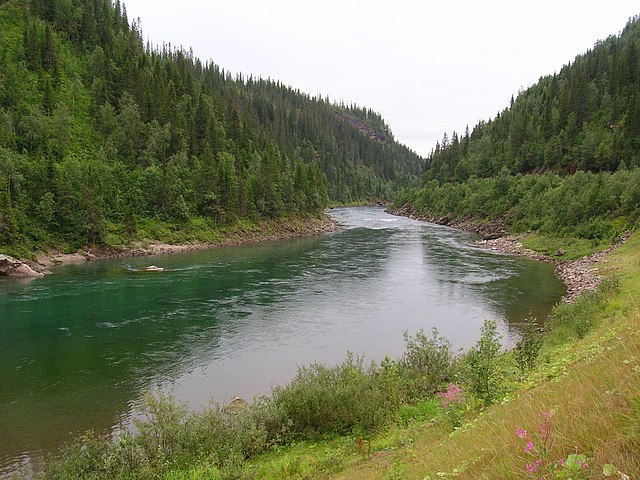Loading AI tools
Ecoregion in Northern Europe From Wikipedia, the free encyclopedia
The Scandinavian and Russian taiga is an ecoregion within the taiga and boreal forests biome as defined by the WWF classification (ecoregion PA0608).[1] It is situated in Northern Europe between tundra in the north and temperate mixed forests in the south and occupies about 2,156,900 km2 (832,800 sq mi) in Norway, Sweden, Finland and the northern part of European Russia, being the largest ecoregion in Europe. In Sweden the taiga is primarily associated with the Norrland terrain.[2]
| Scandinavian and Russian taiga | |
|---|---|
 Forest of Pinus sylvestris with an understory of Calluna vulgaris in Leivonmäki National Park, Finland | |
 Map of ecoregion in northeastern Europe | |
| Ecology | |
| Realm | Palearctic |
| Biome | Taiga |
| Borders | |
| Geography | |
| Area | 2,150,900 km2 (830,500 sq mi) |
The Scandinavian and Russian taiga consists of coniferous forests dominated by Pinus sylvestris (in drier locations), often with an understory of Juniperus communis, Picea abies and Picea obovata and a significant admixture of Betula pubescens and Betula pendula. Larix sibirica is characteristic of the eastern part of the ecoregion. Geobotanically, it belongs to the Northeastern European floristic province of the Circumboreal Region of the Holarctic Kingdom.
There are a number of special status mammals and birds within the Scandinavian and Russian taiga, as well as one reptilian taxon.[1]
Growing season in taiga areas is generally considered to be measured as the number of days for which average daily temperature exceeds 5 °C (41 °F). The longest growing season for the Scandinavian and Russian taiga occurs in the locales with marine influence from the North Sea and Baltic Sea: in coastal areas of Norway, Sweden and Finland the growing season of the closed boreal forest can reach as high as 145 to 180 days per annum. The shortest growing season of the ecoregion is found in continental Russia and at the far northern part of the ecoregion at the ecotone with tundra.[1]
Soil nutrient levels are generally poor, but diversity of soil organisms can attain high levels, particularly in the southern reaches of the ecoregion. In these southern elements of the ecoregion, closed canopy boreal forest with some temperate deciduous tree species interspersed among the dominant conifers, including maple, elm and oak. In some areas of Norway, Sweden, Finland and western Russia, this zone is exploited for agriculture. Some of the elements of the ecoregion are rich in wetlands, as exemplified by the Femundsmarka National Park in Norway, which is replete with marshes and lakes.[1]

There are a total of 368 native vertebrate species in the Scandinavian and Russian taiga according to WWF tabulation; when all migratory bird species are included, this number is somewhat larger.[1]
This ecoregion supports the following native non-endemic threatened mammals:[1]
The Scandinavian and Russian taiga has only a single non-endemic special status native reptile: the Lower Risk grass snake (Natrix natrix).[1]
Native non-endemic threatened avian species in the ecoregion are:[1]

The following is a partial list of protected areas lying within the Scandinavian and Russian taiga:[1]
Seamless Wikipedia browsing. On steroids.
Every time you click a link to Wikipedia, Wiktionary or Wikiquote in your browser's search results, it will show the modern Wikiwand interface.
Wikiwand extension is a five stars, simple, with minimum permission required to keep your browsing private, safe and transparent.